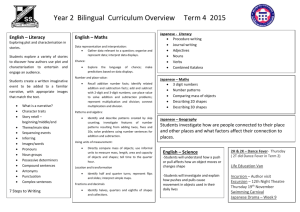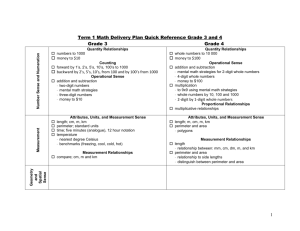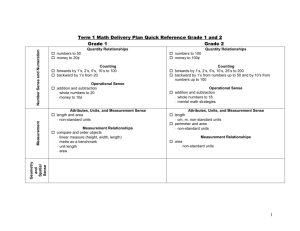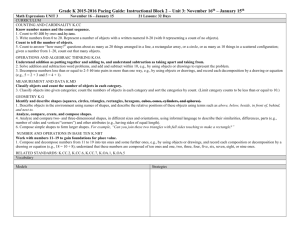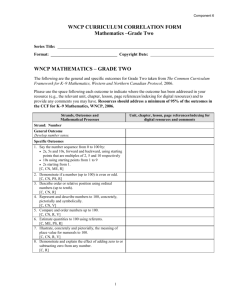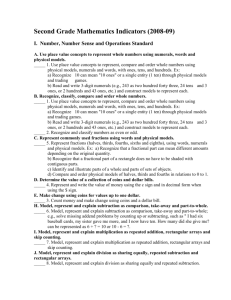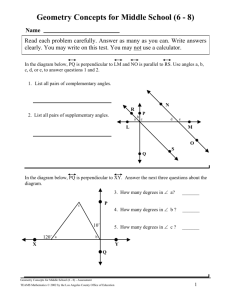Grade 1 Math Curriculum: Addition, Geometry, Time
advertisement
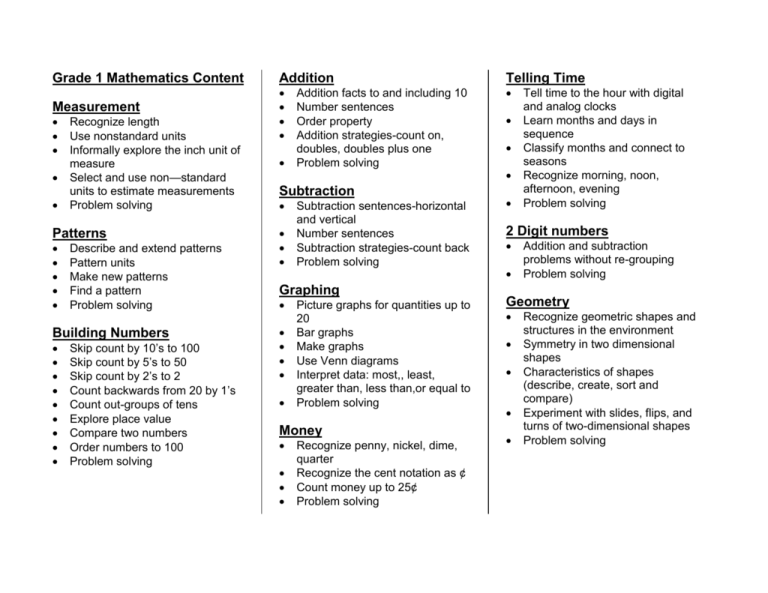
Grade 1 Mathematics Content Addition Telling Time Measurement Recognize length Use nonstandard units Informally explore the inch unit of measure Select and use non—standard units to estimate measurements Problem solving Patterns Describe and extend patterns Pattern units Make new patterns Find a pattern Problem solving Building Numbers Skip count by 10’s to 100 Skip count by 5’s to 50 Skip count by 2’s to 2 Count backwards from 20 by 1’s Count out-groups of tens Explore place value Compare two numbers Order numbers to 100 Problem solving Addition facts to and including 10 Number sentences Order property Addition strategies-count on, doubles, doubles plus one Problem solving Subtraction Subtraction sentences-horizontal and vertical Number sentences Subtraction strategies-count back Problem solving Graphing Picture graphs for quantities up to 20 Bar graphs Make graphs Use Venn diagrams Interpret data: most,, least, greater than, less than,or equal to Problem solving Money Recognize penny, nickel, dime, quarter Recognize the cent notation as ¢ Count money up to 25¢ Problem solving Tell time to the hour with digital and analog clocks Learn months and days in sequence Classify months and connect to seasons Recognize morning, noon, afternoon, evening Problem solving 2 Digit numbers Addition and subtraction problems without re-grouping Problem solving Geometry Recognize geometric shapes and structures in the environment Symmetry in two dimensional shapes Characteristics of shapes (describe, create, sort and compare) Experiment with slides, flips, and turns of two-dimensional shapes Problem solving New York State Education Department Learning Standard for Mathematics Students will understand the concepts of and become proficient with the skills of mathematics; communicate and reason mathematically; become problem solvers by using appropriate tools and strategies through the integrated study of number sense and operations, algebra, geometry, measurement, and statistics and probability. Content Strands Strand 1: Number Sense and Operations Definition Example Students will understand numbers, multiple ways of representing numbers, 1. Verbally count by 1’s to 20. relationships among numbers, and number systems; understand meanings 2. Solve proportions using equivalent fractions. of operations and procedures, and how they relate to one another; compute accurately and make reasonable estimates. Strand 2: Algebra Students will represent and analyze algebraically a wide variety of problem solving situations; perform algebraic procedures accurately; recognize, use, and represent patterns, relations, and functions algebraically. 1. Use a variety of manipulative materials to create patterns using attributes of color, size, or shape. 2. Solve simple one-step equations using basic whole number facts. Strand 3: Geometry Students will use visualization and spatial reasoning to analyze characteristics and properties of geometric shapes; identify and justify geometric relationships, formally and informally; apply transformations and symmetry to analyze problem solving situations; apply coordinate geometry to analyze problem solving situations. 1. Identify and appropriately name twodimensional shapes: circle, square, rectangle, and triangle (both regular and irregular). 2. Classify angles as acute, obtuse, right and straight. Strand 4: Measurement Students will determine what can be measured and how, using appropriate methods and formulas; use units to give meaning to measurements; understand that all measurement contains error and be able to determine its significance; develop strategies for estimating measurements. 1. Compare the length of two objects by representing each length with string or a paper strip. 2. Identify radius, diameter, chords, and central angles of a circle. Strand 5: Statistics and Probability Students will collect, organize, display, and analyze data; make predictions that are based upon data analysis; understand and apply concepts of probability. 1. Display data in bar graphs using concrete objects with intervals of one. 2. Calculate the mean for a given set of data and use it to describe a set of data. S:\Ci\MS Word\Math\New Parent Handouts 2005\Gd.2. Parent Handout.doc 1. Example for Primary Instruction. 2. Example for Intermediate Instruction.





